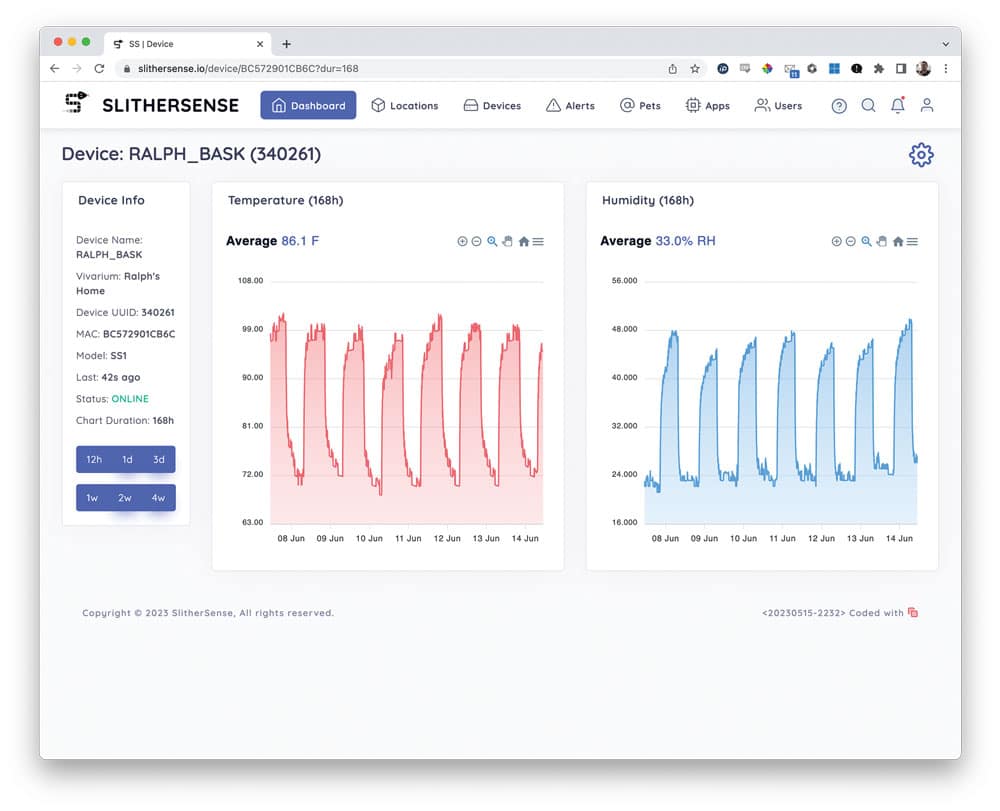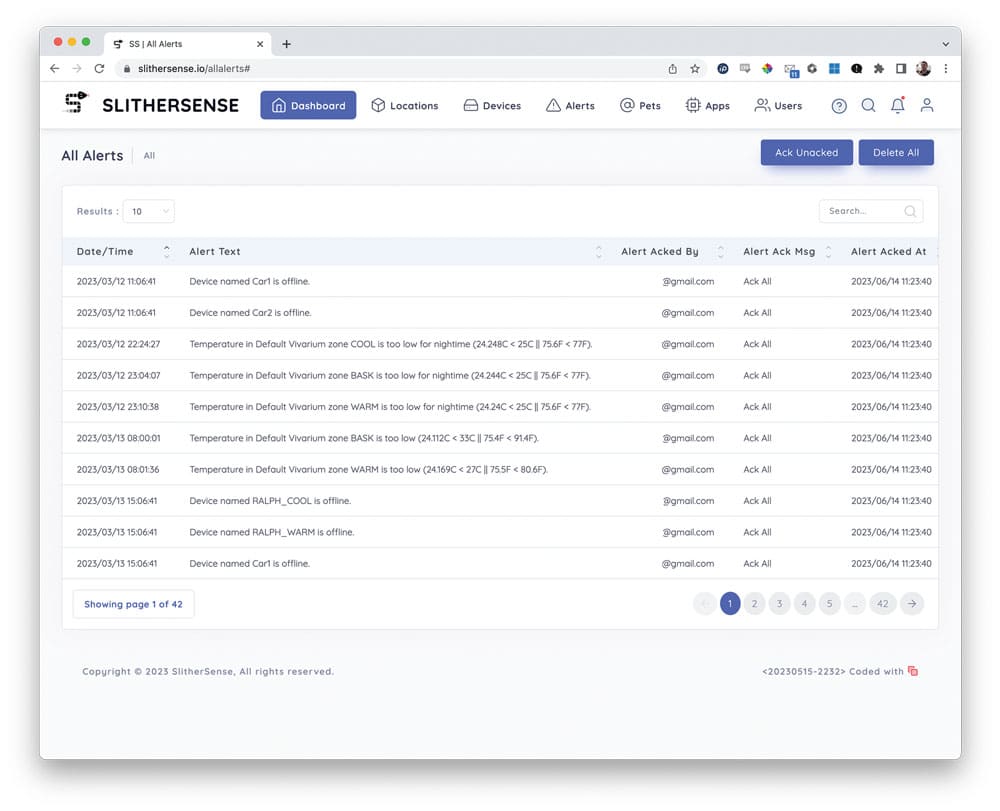Remote monitoring systems are the next step in herpetoculture and should definitely be considered by anyone serious about the welfare of their animals.
Growing up in the 1970s I have many memories of keeping herps as a child. The conditions were very basic, with usually only a 10 gallon metal-framed aquarium and a window screen cover. Times have certainly changed and we now live in a world where knowledge of reptile and amphibian husbandry has grown exponentially. In addition there has been a boom in products related to keeping reptiles, amphibians, and invertebrates. There is now a huge array of lighting, heating, food supplements, enclosures, misting systems, and so forth readily available. One of the more recent frontiers in vivarium products is remote habitat monitoring technology.

Both sides of the enclosure can be monitored separately with two sensors.
As mentioned in one of my previous articles, the enclosures and associated technology in my personal collection are in the process of being updated. While transitioning to modern style vivaria has been the primary goal, I recently had the opportunity to review the SlitherSense Vivarium Monitoring System. The offer to review this product was welcomed since I had eventually planned on investigating the possibility of incorporating a remote monitoring feature.
As a child of Generation X, I have grown up watching the incredible progression of technology to where it is currently. While I can satisfactorily navigate my smart phone as well as the various electronic charting systems that I use as a travel nurse, I have never considered myself particularly well-versed with much of today’s gadgetry. Despite wanting an upgrade, there was admittedly some trepidation involved when first taking on this project.

The temperature and humidity shown on a single screen.
My mind was more at ease when opening the system after receiving it in the mail. The packaging is compact and the simplicity of the kit is obvious. It includes two pieces of hardware along with a charger cord. A brick is not included with the cord. It is explained in the instructional video that this decision was made not only to reduce cost but also because the typical household generally has extra bricks laying around.
Instructions for installation are found on the company website, www.slithersense.com. In essence the system consists of the gateway monitor and a sensor. Depending on enclosure size, one sensor is required for each zone. Downloading the SlitherSense app on a smartphone is required in order to register the device and monitor the readings, and can be used for local, real-time monitoring without having to visit the website. The sensors are designed to be affixed to a smooth surface such as glass or plastic. There are rivet holes at the top and bottom of each unit so that it can be screwed into wood if needed. My one observation is that the white color stands out when placed in a naturalistic enclosure. The sensor measures 8.89 cm x 3.81 cm x 1.9 cm (3.5 in x 1.5 in x 0.75 in) however so it can be easily camouflaged if desired.

Placement of the SlitherSense sensor.
Five enclosures were chosen for sensor placement. The chosen enclosures range in size from a 121.9 cm × 60.9 cm x 60.9 cm (4 ft x 2 ft x 2ft) living room enclosure that houses our lone pet bearded dragon (Pogona vitticeps) to a 37.8 liter (10 gallon) enclosure in our reptile room housing a young Florida banded watersnake (Nerodia fasciata pictiventris). The remaining sensors were also placed in various enclosures in our reptile room. Four of the five enclosures are either all glass, or of significant glass construction. Sensors were mounted in enclosures that represented a range of various habitats, from a paludarium containing various species including crocodile newts (Tylototriton kweichowensis) and freshwater shrimp (Neocaridina davidi) to an open-air screened enclosure housing Mexican alligator lizards (Abronia gramenia) to a more arid vivarium with leopard geckos (Eublepharis macularius).
Since I do not name my animals, I skipped the create a pet step on most of the enclosures and just named the species kept in each enclosure.
The sensors read two to three zones depending on vivarium size. Enclosures less than 75.7 liters (20 gallons) are divided into two zones, bask and cool. Enclosures 121.9 cm × 60.9 cm x 60.9 cm (4 ft x 2 ft x 2ft) and larger are divided into three zones, bask, warm, and cool.
Once installed, temperature and humidity readings are instantly available.
Initially there were a few hiccups with the overall process. The Gateway unit was initially placed in the living room next to the bearded dragon enclosure. The next day I received email alerts informing me that three sensors in the reptile room were off line for a period of time.
This issue continued off and on while the Gateway was in the living room. Moving the module to the reptile room with the other sensors resolved the situation, with only occasional disruptions due to my home internet service. The company was good to keep an open line of communication going however and the few glitches were quickly resolved.
The app is designed to organize however many vivaria are utilized by breaking it down to location, such as reptile room, living room, and so forth. Devices are the individual sensors in each enclosure. According to the founder, it is possible for the system to handle something as large as a zoo with multiple buildings. The company states that it is all about logical organization of the various environments. Storage units are like vivaria but lack temperature zones (Bask, Warm, Cool) they just have a single temperature/humidity high/low that all devices assigned to the SU are responsible for monitoring. One example pointed out for good would be a refrigerator or freezer storing food. The SS1 sensor devices are capable of measuring temperatures between -40 degrees Celsius and 70 degrees Celsius with a 0.3 degree accuracy. While there is no known reptile that requires a 70 C basking spot the versatility of the temperature range enables the system to be suitable for other functions, such as storage.

Email alerts on the SlitherSense Dashboard.
One feature allows for individually named animals with options to include animal type, Wikipedia link, notes, birthdate, and icons to be assigned. One aspect that I found curious is if one wants to assign an animal type, which is the Latin name, there is a lengthy yet seemingly haphazard list of species to choose from. There are many common species listed such as leopard geckos and corn snakes (Pantherophis guttatus), yet there are also extremely rare species found in only specialists collections such as Ouroborus cataphractus and even species only found in zoos such as the Galapagos land iguana (Conolophus subcristatus) and Komodo dragon (Varanus komodoensis). There is even an option to choose a Galapagos marine iguana (Amblyrhynchus cristatus).
Conversely, there is not one single caudate species listed, with instead the whole Order displaying as “Salamander – Other (Urodela et al.)” I asked about the rationale behind choosing the list and the response was that it began with a list of herp types, such as frog, gecko, iguana, and so forth. Then, googled topics such as top 10 pet geckos were added. A Wikipedia search was used for determining climate settings, which are just starting points or recommendations, and that the user is free to customize for specific needs. In addition, the founder states that a “Request a Pet Type” button will be added in the near future. There are other features as well, such as a calendar and a Todo list, which are still in the process of being installed at the time of this writing.

SlitherSense Dashboard showing the last 7 days of temperature and humidity.
SlitherSense touts itself as “an easy-to-use platform for monitoring your pet’s vivarium/terrarium “adding that it can be used for any container.” The company was started by Nick Garner, with help from his three sons, Ren, Ryo, and Rei. According to his website, Nick wanted to engage his sons’ interest in constructing things by using their bearded dragon, Ralph, as inspiration for a new project.
As previously mentioned this is my first experience with a remote monitoring system, so I have nothing to compare it to. A Google search only revealed a few similar products. The price point is fair with The Two Zone Kit, which includes one SS Gateway and two SS1 temperature/humidity sensors selling for USD $95.99. The products are sold online through an Amazon.com store.
The website states that “Accounts start with enough credits to run for free, for years,” adding “After that, pay for what you use. We will never charge a recurring subscription.” I reached out to the company for clarification on this and it was explained that credits are used to cover costs for services such as sending emails, texts, or storing data for long periods of time. The company stressed that with proper tuning of the settings it is possible to run the system for years free of charge. It was further explained that whenever credits are exhausted, the user can purchase more to top up the account. Users will be alerted when credits are depleted and functions that consume a credit will cease operation. It is stressed that regardless of credit status there will never be the inability to see current temperature settings.
Overall, the SlitherSense Vivarium Monitoring System is well worth the reasonable cost. Despite a few minor discrepancies in the beginning, the system has operated well for several months now. The ability to monitor temperature and humidity readings on a smartphone is an especially positive aspect for those like myself, who work out of town and may not be able to spend any length of hands-on time with enclosures for days at a time. If only one or two vivariums containing hardy species are being maintained, then the SlitherSense system could be viewed as not the most essential piece of equipment, unless one enjoys gadgetry and wants to add all the bells and whistles. The system truly shines however with serious hobbyists and breeders who keep multiple enclosures, or even those who may keep a few vivaria housing delicate species.
Remote monitoring systems are the next step in herpetoculture and should definitely be considered by anyone serious about the welfare of their animals.
For More Information:
•
SlitherSense Vivarium Monitoring System
• $95.99
• https://slithersense.com/



